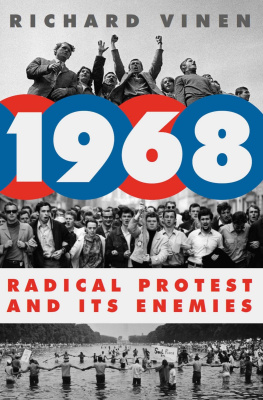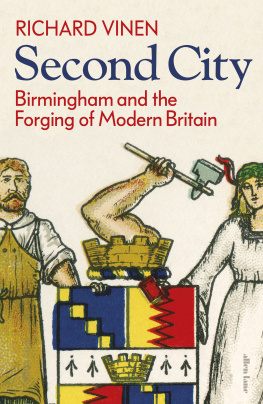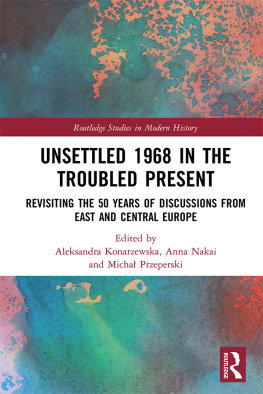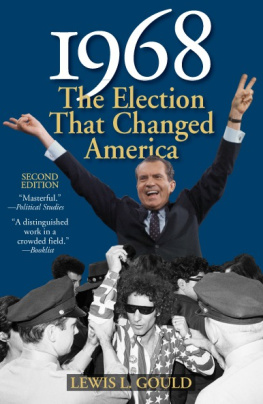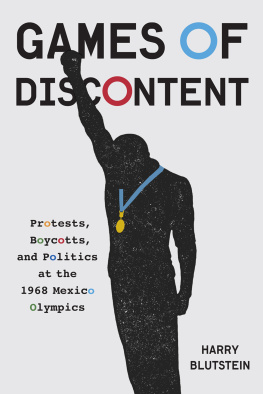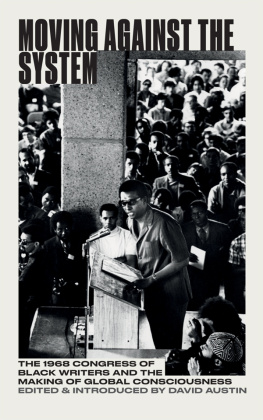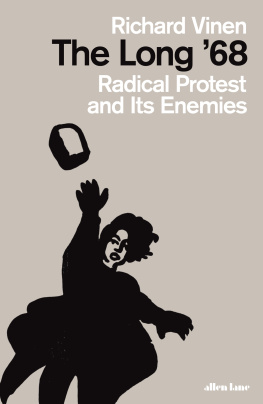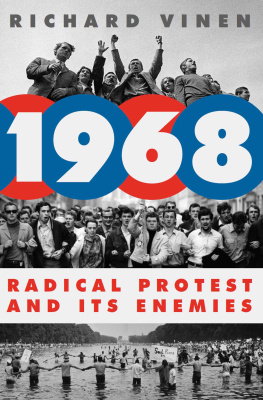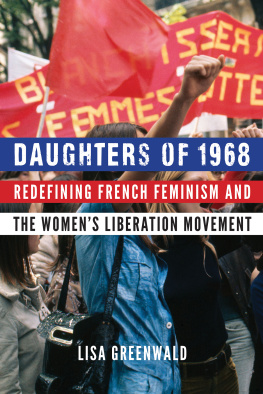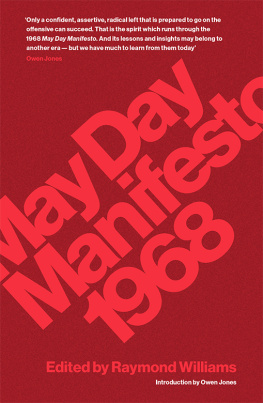For Alex
Contents
1. WORDS AND THE THING: DEFINING 68
Beauty is in the street. Poster, 1968. The most famous lithographs of 1968 were mainly produced by the collective at the Beaux Arts school in Paris. Generally, 23,000 copies of each were printed. This poster was produced in Montpellier and not much seen in 1968 itself. However, by the time of a sale in 2008, it had become the most valuable of all the soixante-huitard prints partly perhaps because feminism had become an important part of the prism through which people looked back on 1968. It was sold at auction for over 3,000 euros. Photo: Bibliothque Nationale de France, Paris
2. THE 68 GENERATION
Meeting of Students for a Democratic Society at Bloomington, Indiana in September 1963. The photo was taken by C. Clark Kissinger. He wrote: I asked everyone to raise a clenched fist salute just before I snapped the photo, as a symbol of the new resistance coming into being. Note the conservative dress sense of most participants and the smiles are they laughing at themselves for giving clenched fist salutes?
From left to right, Tom Hayden, Don McKelvey, Jon Seldin, Nada Chandler, Nancy Hollander, Steve Max, Danny Millstone, Vernon Grizzard, Paul Booth, Carl Wittman, Mary McGroaty, Steve Johnson, Sarah Murphy, Lee Webb, Todd Gitlin, Dick Flacks, Mickey Flacks, Robb Burlage, Rennie Davis. Photo: C. Clark Kissinger
3. UNIVERSITES
Malcolm X with members of the Oxford Union, 1964.
Malcolm X was invited to Oxford to debate the motion Extremism in the defence of Liberty is no vice; moderation in the pursuit of Justice is no virtue. The phrase had been coined by the right-wing Republican senator for Arizona Barry Goldwater. Malcolm X, who was sceptical of white liberals, thought a Goldwater victory in the 1964 presidential election desirable because it would make political choices clearer. He spoke in favour of the motion. Malcolm Xs own politics were evolving fast in 1964. He had recently left the Nation of Islam and was less enthusiastic about racial separation than he had sometimes seemed in the past.
The presence of a black revolutionary in the Oxford Union was less incongruous than it might first appear. Though Oxford students were primarily white, the university had never imposed the kind of racial segregation that would have been taken for granted at its namesake in Mississippi. The first non-white president of the Union had been elected in 1942 and Eric Abrahams, the president of the Union who invited Malcolm, was from Jamaica. His successor, Tariq Ali, was from Pakistan though, as he told Malcolm, he was a Muslim in name only. Both Ali and Abrahams had been gated, i.e. subject to a form of academic house arrest, for participation in demonstrations about the imprisonment of Nelson Mandela they had special permission to leave their rooms to attend debates at the Union. Malcolm had probably encountered Oxford undergraduates before he came to Britain because debating teams from the university had visited the Norfolk Penal Colony in Massachusetts when he was incarcerated there.
In retrospect, the most striking feature of Oxford in 1964 concerned sex rather than race. Women had only been admitted to the Union in 1963, and only two of the eighteen officers of the Union (Suzanne Maiden and Prue Hyman) were women. The first female president of the Union (Geraldine Jones) was elected in 1968. Malcolm X often spoke in highly gendered terms (though his position on relations between the sexes was one of the areas in which his attitudes seemed to be changing fast). He referred in his speech to the castration of black men in the United States. Photo: Gillman & Soame, Oxford
4. THE UNITED STATES
Robert Kennedy (left) and President Lyndon B. Johnson address the crowd during the presidential campaign, New York, 15 October 1964.
Hey hey LBJ, how many kids have you killed today?. Lyndon Johnson old, ugly and vulgar came to stand for everything that 68ers despised, especially during the Vietnam War. Robert Kennedy young and idealistic was one of the few politicians that some 68ers respected. The differences between the two men were, however, complicated. Kennedy was closely associated with the policies that his brother had initiated in Cuba and Vietnam. LBJ was, until the escalation of the war in Vietnam, sometimes seen with grudging admiration by the left members of Students for a Democratic Society wore badges saying Half the way with LBJ. Photo: Cecil Stoughton/Lyndon Baines Johnson Presidential Library and Museum, The Universityof Texas at Austin
5. FRANCE
Boy and girl on a bicycle, Avenue des Champs-lyses, Paris, 1968.
Though this appears at first glance to be a photograph of student protest, it looks, on closer examination, as though these young people are attending the pro-Gaullist demonstration of 30 May 1968. Photo:Henri Cartier-Bresson/Magnum Photos
6. WEST GERMANY
Demonstration on the Kurfrstendamm, Berlin, after the attempted assassination of Rudi Dutschke, April 1968. Photo: Alex Waidmann, ullstein bild via Getty Images
7. BRITAIN
Karl Dietrich Wolff (on the left), Tariq Ali (centre) and Daniel Cohn-Bendit at Karl Marxs tomb in Highgate Cemetery in mid-June 1968.
The three men had been brought to London to appear in a BBC documentary on student protest. Perhaps the French historian and ex-Communist Annie Kriegel was thinking of this photograph when she wrote that 1968 failed to produce any new ideology but rather, like flowers placed on graves on All Saints Day, gave an appearance of life to old ones. Private Eye used the photograph for one of their covers and had the three men singing Theres no business like show business. Cohn-Bendit looks uncharacteristically subdued perhaps because he was not really a Marxist. James Callaghan, the British home secretary, said that he had permitted Cohn-Bendit to enter the country so that he could teach him the words of the Internationale, as he does not seem to be too sure of them. Photo: Keystone-France/ Gamma-Keystone via Getty Images
8. THE REVOLUTION WITHIN THE REVOLUTION: SEXUAL LIBERATION AND THE FAMILY
Rudi Dutschke with his baby son, April 1968.
Some argued that the political radicalism of the late 1960s went with macho posturing by men and that the womens liberation movement of the 1970s was, in part, a reaction against such behaviour. However, the attitudes of male radicals were sometimes more complicated than they first appeared. Beneath his lurid rhetoric, the German student leader Rudi Dutschke was a gentle person. Here he is with one of his children. His son was, inevitably, called Che. Photo: Interfoto/Alamy
9. WORKERS
Alfa Romeo workers in 1972. Photo: Uliano Lucas/Alinari Archives
10. VIOLENCE
Wanted poster for members of the Weather Underground, issued 20 October 1972. The FBI, even more than police agencies in other countries, helped define the long 68. Public domain
11. DEFEAT AND ACCOMMODATION?
Jack Straw, president of the Students Union at Leeds, dances with the Duchess of Kent, chancellor of the university, in 1968. Though on the left of the British student movement, Straw was not a revolutionary, even before he began the long march that would take him to being a minister in the Blair government of 1997. Photo: The Yorkshire Post/ Reproduced with the permission of Special Collections, Leeds University Library
CONCLUSION
Student protest touched almost every corner of the Western world in 1968. The photograph depicts a May Day demonstration in Jyvskyl in provincial Finland. Usually student and worker demonstrations were separate but on this occasion Socialist and Communist workers joined students. The demonstrators were asking for more democracy in the workplace and at the university. They were also protesting against plans to build a highway through a historic park in the city. Mikko Pyhl has just thrown his student cap into the fire, as have Marjatta Pyhl, Ismo Porna and his wife Virpi. The incident looks as though it is modelled on protests in Paris but it actually took place just before the Paris events. The confrontation with authority in Finland was less stark than in many other countries. The burning car was, in fact, a wreck that had been purchased by the students and burnt with the permission of the police. Most of the protesters aims were achieved. Mikko Pyhl, who became one of the first student representatives at the university in 1969, later served as an ambassador. Erkki Liikanen, who repeated the cap-burning performance at Mikkeli in the following year, later became president of the Bank of Finland.
Next page
